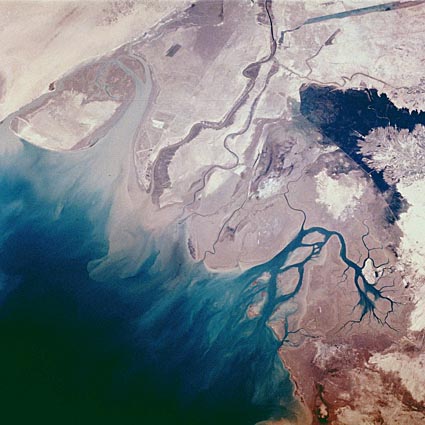|

The joint Tigris/Euphrates delta. The Tigris is on the right.The Tigris flows through Turkey and Iraq in western Asia. Its headwaters are in the Southeastern Taurus Mountains at Lake Hazar north of Diyarbakir. The climate of the Tigris has a dry summer and wet winter. Snows fall on the high mountains and melt in spring. Annual floods are a feature of the river. The southern part of the river flows through a desert. The river is a lifeline to many desert peoples. The river flows southeastward for 1900 kilometres (1200 miles) where it joins the Euphrates in the Shatt Al-'Arab, an inlet of the Persian Gulf some 200 kilometres (120 miles) long. The headwaters and the upper 450 kilometres (280 miles) are in Turkey, it then forms part of the Syrian border. The lower part is in Iraq. In its upper course, the Tigris is deeply trenched into the mountain, flowing through many gorges and split by rapids. The Turks are now underway putting dams into this upper reach, much to the worry of the Iraqis and Syrians who fear they will lose vital water. The first part of the river in Iraq is not dammed above Mosul giving a reservoir some 160 kilometres (100 miles) long. Between Mosul and Al-Fathah the Tigris receives two tributaries, the Great Zab and the Little Zab. These provide as much water again as flows in the upper Tigris during the spring snowmelt. Some 160 kilometres (100 miles) upstream of Baghdad, the narrow valley ends and the Tigris flows out onto a broad plain. From this point on the river meanders across the plain and there are many oxbow lakes. During the floods the river is very liable to shift its course. In ancient times this flood kept the area near the river fertile, but it also resulted in much destruction and loss of life and the Tigris is now embanked to try to prevent the river shifting position and flooding. By the time the river is 300 kilometres (200 miles) downstream of Baghdad the material it is carrying is mainly silt and sand and so the river stops meandering and flows in many braids with dividing islands. In this lower reach there are wide marshlands which were cultivated since ancient times. Whole villages are built on floating islands in this marshland.
|